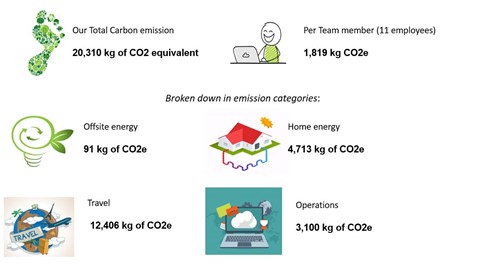Our 2019-2020 Carbon Footprint
As part of our climate commitment, we finalised our carbon footprint report for the UK tax year starting from April 2019 until the end of March 2020.
After our previous report’s calculations and results, I think we became more aware of our individual carbon footprints as well as the company’s. We saw the numbers and understood the equivalents. We found out in which categories we had the highest emissions and discussed what we can do to reduce our carbon footprint in these categories and in total. We shared our thoughts and suggestions on improving and offsetting, and we will continue to do so in the future.
Jack O'Donoghue, our freelance sustainability consultant, helped us put together the first report. Thanks to his great help, I managed this new report more on my own, with all data inputs coming from the rest of the Team.
The process of collecting our Team and Company data consumptions was based on several factors:
- Commuting
- Global gatherings (we had two meetups - one in La Clusaz, France and one in Liverpool)
- Other business trips
- Home energy and offsite energy consumption
- Operations emissions, which include our Team equipment procurement and usage and the emissions from our servers and websites
Using the most accurate assumptions per category and per country (such as the “UK Greenhouse gas reporting: conversion factors 2019”), we came to the final calculations of our analysis.
The Results (April 2019 - end of March 2020)

Scopes:
Just as a reminder that the scopes used come from the internationally recognised Greenhouse Gas Accounting and Reporting principles:
- Scope 1 - Direct Emissions: Activities owned or controlled by the organisations that release the emissions.
We don’t have any energy sources ourselves.
- Scope 2 - Indirect Emissions: Emissions being released into the atmosphere associated with the consumption of purchased electricity, heat, steam and cooling.
We had 3,191kgCO2e in this Scope. This includes energy usage during meetups and our equipment use.
- Scope 3 - Other Indirect Emissions: Emissions that are a consequence of your actions, which occur at sources which you do not own or control and which are not classed as scope 2 emissions (e.g. travel).
We had 17,119kgCO2e in this Scope. This includes our home energy usage and travel.
Key insights
- Our total carbon emission is 16% increased than last year. We are aware it is because of our Team having more employees than the previous year and more long-distance flights as well as an increase of the Data storage emissions: 2,619kgCO2e and last year we had only 432kgCO2e
- Also, 16% of all emissions are included in scopes 1 or 2. This indicates that HappyPorch’s direct emissions are still low
- We still have a low physical footprint as we are a remote company and have almost no commuting
How to reduce or carbon footprint going forward
Our Team discussed that we already know that due to the global pandemic of Covid19, our next report that applies to the tax year 2020-2021 will be significantly lower than our previous years. The simple explanation is that we did not have our regular global gatherings and business travel trips during this year.
Still, we continued with developing a plan to achieve our emission reduction target and here are some of our plans:
- At this very moment we are redesigning our website, which would mean that we will try to decrease our carbon footprint and become more “green” - efficient and sustainable.
- We set goals for committing to working with our clients to offset and reduce our Scope 3 emissions in that way.
- We committed to become Carbon Negative by doing Carbon Synching.
- We made an SME Climate Commitment to achieving net zero emissions before 2030 and disclosing progress every year.
Offsetting
After getting our final report results, we decided to offset our carbon footprint twice- just like we did last year. First, we planted 25 more trees in our HappyPorch grove in the Trees for Life programme that revitalises wild forests in the Highlands of Scotland. Second, we also contributed to the carbon offset programme of Climate Care.
Recently, we also had a chance for another significant investment in our CO2 offsetting. So we decided to plant 833 more trees in our HappyPorch grove and in that way contribute to Carbon Syncing. Carbon Syncing is an idea to suck carbon out of the atmosphere in approximately the same volume and timescale as we are emitting it. With planting those trees we covered 16 tonnes CO2e per year (79% of our 20.31 tonnes for 2019-2020) for the next 30 years.

